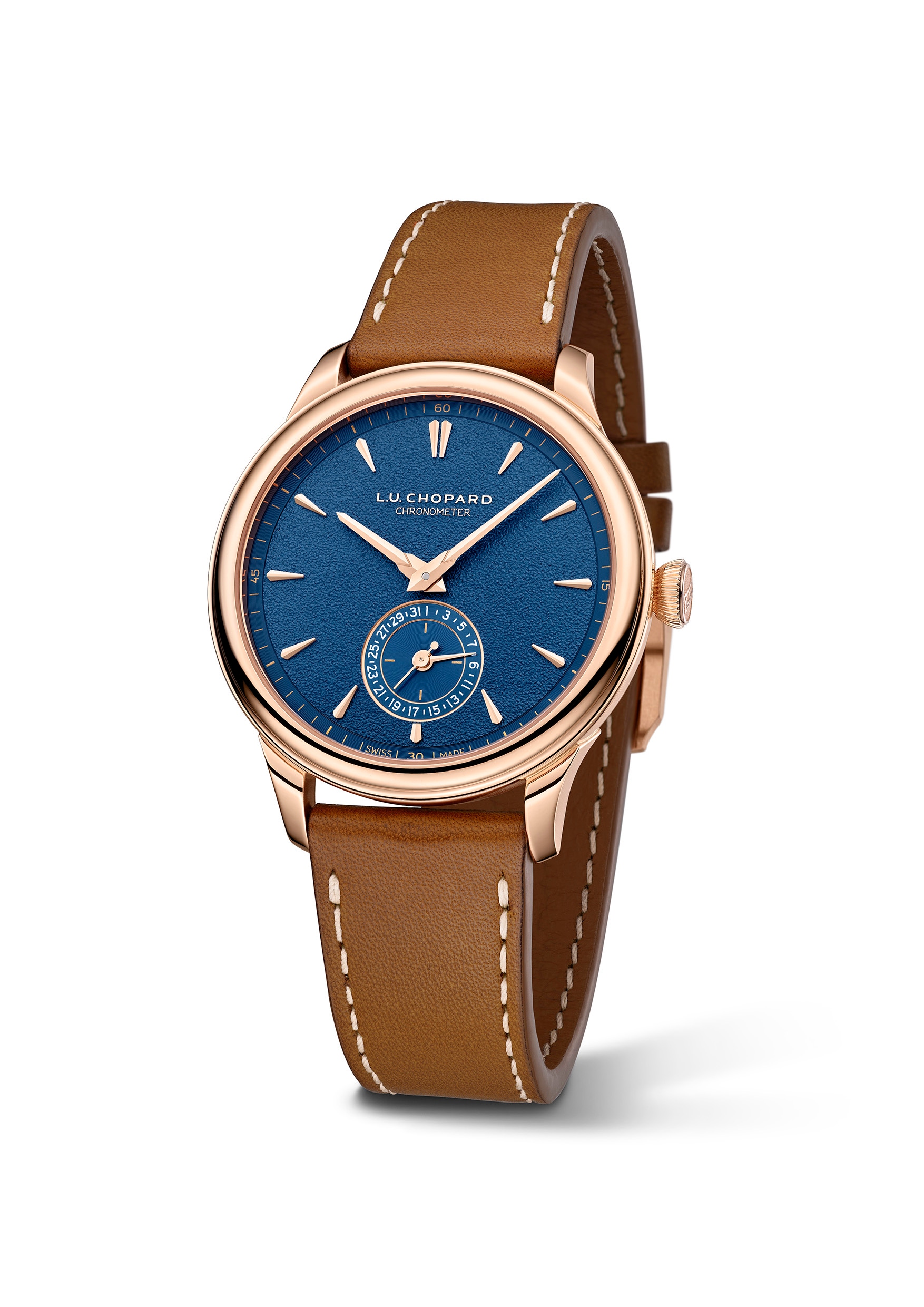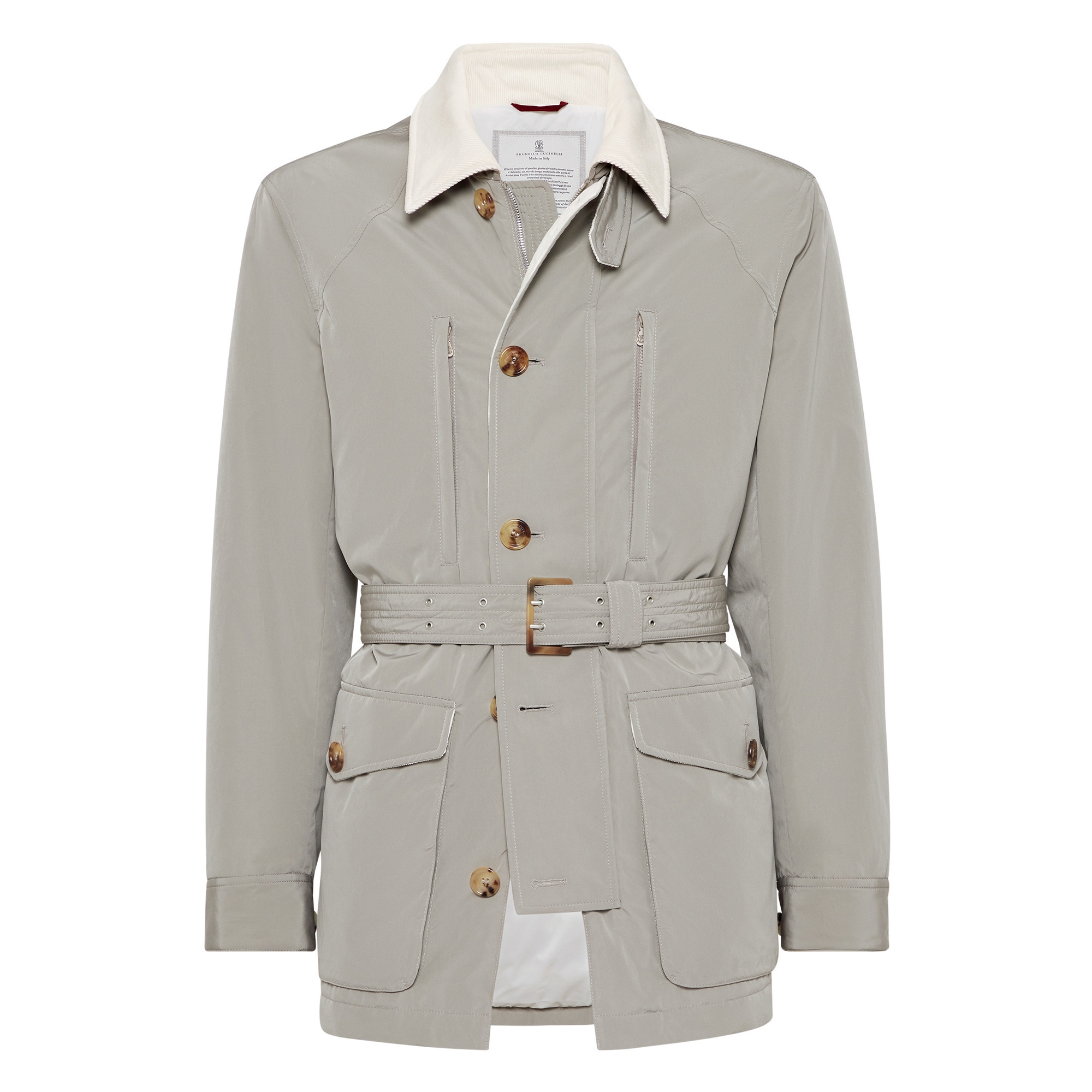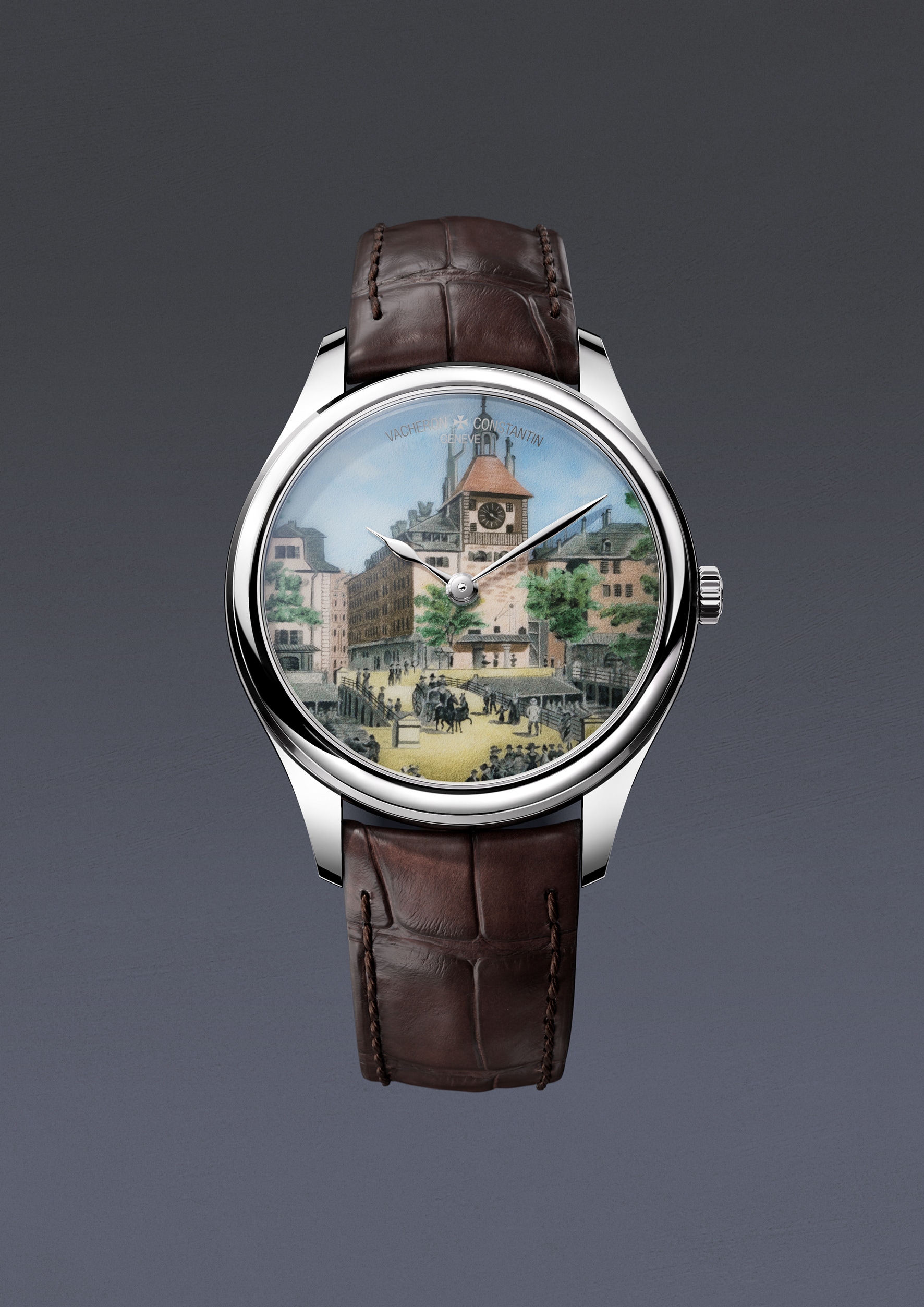Invest
Investments can be unpredictable, but not so with these four winners, which we have handpicked to provide you with sound and secure appreciation — aesthetically, spiritually and financially.

CHOPARD L.U.C. QUATTRO IN ROSE GOLD WITH BLUE DIAL
Removed and stretched out, the electrical wiring in a Concorde could tether the edge of the observable universe to the Yeovil aerodrome’s windsock. Remove, tie together and extend all the blood vessels in a single human body in the same fashion, and you could tickle God’s nose with the resulting length of twine.
For those of us whose childhood involved visits to far-flung military museums that count the decommissioned supersonic airliner among its tour options — as well as the kind of biology books that attempted to pique students’ interest with enjoyable but iffy statistics — it is easy to become immune to such statistics (exaggerated for comic effect here, admittedly).
But when, as fully grown and discerning adults, we encounter an equivalent factoid that involves the cramming of a vast quota of functional material into a space a fraction of the size of a human body, let alone a Concorde — and, more importantly, is completely true — the sane among us must hold up our hands and let our jaws drop in reverence. One of these moments came a quarter of a century ago, when Chopard launched its first L.U.C Quattro timepiece.
Chopard’s Quattro technology sees four series-coupled barrels stacked in pairs, which, combined, make up exactly 1.885 metres of springs. It’s impossible to overstate what a feat of micro- engineering ingenuity it is to pack this configuration — the only one of its kind in the world — into a piece of machinery that can be worn on the wrist. And that’s before we factor in performance: a power reserve of 216 hours, or nine days, thanks to the resulting constant force to the escapement and a 28,800 vibrations-per-hour oscillating rate, ensuring the kind of impeccable precision that will prompt the C.O.S.C. institute to chronometer-certify the piece.
Naturally, such technical ingenuity being repackaged with such elegance in Chopard’s new novelties, showcased at this year’s Watches and Wonders, was one of the event’s highlights. Our pick, after much deliberation, is the piece seen here, which comes in ethical 18-carat rose gold and features a 39mm case with blue dial.
Elsewhere among Chopard’s newly announced novelties, an exceptional platinum version of the Alpine Eagle sports watch collection with ultra-thin case, whose dial — adorned with a ‘shades of ice’ blue gradient, which pays tribute to Alpine glaciers — also caught our eye, as did a new 26mm-diameter model in (ethical, naturally) 18-carat white gold. The latter piece’s textured mother-of-pearl dial, surrounded by diamonds set using Chopard’s signature crown-setting technique, was also among the most aesthetically striking pieces on display in Geneva.
But technologically speaking, the piece before you — and how its antecedent, a quarter of a century ago, redefined how horological ingenuity can pack so much into so little space — really deserves the ‘best in show’ plaudit. - Nick Scott


BRUNELLO CUCINELLI PADDED PARKA
There’s not a great deal — bar ownership of 23 pairs of chromosomes — that unites the Inuit of the Canadian Arctic, U.S. soldiers of decades yore, and young working-class members of the Mod movement in 1960s Britain. The link, of course, is parkas: seal- or caribou-skin outer-garments, often coated with fish oil in the case of the North Pole denizens who invented them to shield themselves from the bitter Arctic conditions when hunting and kayaking; in the case of the soldiers, military- issue M-51 ‘fishtail’ coats created to combat the brutal climes on the frontline in the Korean war; and, in the case of the Mods, those same hip-length, army-green pieces purchased from London ex-military outfitters and worn to protect their tailored mohair zoot suits while driving their Lambrettas and Vespas to Brighton for a mass beach brawl.
It’s impossible even to estimate how many iterations of the parka have been produced by fashion giants in the decades since the Mods brought them into popular culture, but the one you see here, so different to what has come before — and an outlier for a
brand known as a pioneer of the quiet luxury fashion movement and whose eponymous founder has been dubbed the ‘king of cashmere’ — is the most desirable we’ve set eyes on.
Its humble origins may be long behind it, but the parka remains a utilitarian piece, so it’s apposite that this one has been made using high-tech performance fabrics: specifically, the water- resistant microfibre Thermore padding with which it is insulated (something the 1st Marine Division battling the elements in North Gyeongsang province would have relished; the young British hoodlums battling the rockers on Brighton beach less so).
A retro sporty feel is ensured by the horn buttons, corduroy inserts and a silhouette that is seriously sharpened up by a belt, while the fabric surface has a smooth and silky feel, afforded a subtle shimmer by a finishing process that includes mysterious but magical treatments to make it more water resistant.
Like its Brunello Cucinelli stablemates, it’s a piece that looks in situ on the bustling thoroughfares of Milan but is manufactured in the medieval hamlet of Solomeo. - Nick Scott


VACHERON CONSTANTIN LES CABINOTIERS TRIBUTE TO THE TOUR DE L'ÎLE
This is by no means the first Vacheron Constantin piece to celebrate the Tour de l’Île, the remains of a fortified castle that perches on an island in Geneva’s sliver of the Rhône river. Neither is it the most complicated — the Tour de l’Île Grand Complication created to celebrate the brand’s 250th anniversary in 2005 has 834 parts and 16 complications (including minute repeater, sunset time, perpetual calendar, second time zone, tourbillon and equation of time and sky chart) housed within its 17.8mm-thick case.
Unsurprisingly, since the tower was the manufacture’s home from 1842 to 1875, it is also not the first Vacheron Constantin timepiece to depict it (the iconic edifice was intricately hand- engraved on the dial in pink, yellow and white gold as part of the house’s Memorable Places series in late 2023). For our money, though, the watch before you is the most elegant and eye-catching tribute to date of a building, completed in 1219 by the Bishop Aymé de Grandson, that serves as a symbol of the city’s tenacity in the face of its own densely plotted history.
One of three 40mm pieces released to celebrate the manufacture’s 270th anniversary, all blessed with the technical and aesthetic mastery of Vacheron Constantin’s Maison Métiers d’Art workshop, its miniature Grand Feu dial features a reinterpretation
of a lithograph drawn by local artist Jean DuBois, enamel-painted in pastel shades, conjuring up the scene in the style of a detailed watercolour. It’s an evocative conversation prompt, especially when you remove it and show your companion a caseback on which is inscribed Geneva’s motto, Post Tenebras Lux (‘After darkness, light’ — a rallying call to freedom, independence and progress), which dates back to the mid 16th century and is found on the dial of the actual clock on the Tour de l’Île.
The decoration was carried out using the Geneva Technique — a method by which miniature illustrations are rendered, fired and sealed with several layers of clear enamel, which enhances depth and vivacity — by Les Cabinotiers, an artisanal division that was, according to Sandrine Donguy, Vacheron Constantin’s Product and Innovation Director, “established to enable the highest expression of Vacheron Constantin’s quest for both technical excellence and artisticbeauty”, and “is driven by a passion for translating technical and artistic dreams into reality”.
The second of the trio of pieces celebrating the 270th anniversary, also in platinum, renders the building in guilloché and Grand Feu enamel; a third sees it engraved on a pink-gold dial set within a pink- gold case. All with a brown Mississippiensis alligator strap. - Nick Scott


SIR WINSTON CHURCHILL PORTRAIT BUST AT THE ARMOURY OF ST. JAMES'S
The bronze Churchill bust, crafted by Tristram Lewis, is a brilliant item for commemorating the 80th anniversary of V.E. Day, offering profound spiritual resonance and sound financial appreciation. This bust captures the essence of Churchill. V.E. Day marks the culmination of Churchill’s unwavering resolve and the collective spirit of a nation united against tyranny. This bust serves as a powerful reminder of the sacrifices made and the resilience displayed during world war II, fostering a sense of national pride and gratitude.
The bust’s creation, as part of a landmark equestrian statue for Blenheim Palace, further amplifies its spiritual significance. Blenheim, Churchill’s birthplace, holds a special place in British history and his personal story. Placing this bust, a precursor to the grand statue, within the context of V.E. Day celebrations elevates it beyond a mere artistic representation. It becomes a symbol of Churchill’s return to his roots, a homecoming that echoes the nation’s return to peace. The fact that the Duke of Marlborough enthusiastically supports this project adds a layer of historical authenticity and prestige, reinforcing the bust’s spiritual value.
Financially, this bronze bust presents a compelling investment opportunity. Tristram Lewis is an established and highly regarded sculptor whose works are increasingly sought after. His recent successes, including the Grenadier Guards’ commission for King Charles III, attest to his talent and growing reputation. The Armoury of St James’s, with its extensive experience in Churchill portraiture, confidently asserts that this new work will stand out as an exceptional addition to the canon.
There will have been about 25 of these made, and the two the Armoury have is numbers two and three. Combine this with the historical significance of the subject and the artist’s rising prominence, and it creates a desirable collectable. As V.E. Day anniversaries pass, the bust’s historical relevance will only deepen, enhancing its value. The intrinsic quality of bronze, a material that ages gracefully, further ensures its longevity and enduring appeal.
In essence, this bronze Churchill bust is not just a commemorative piece, it’s a tangible piece of history, a work of art, and a sound financial investment, perfectly aligned with the spirit and significance of the 80th anniversary of V.E. Day. - Tom Chamberlin





